
Home
Services
About us
Blog
Contacts
Custom Mobile App Development for Smart Scales: From Weight Tracking to Wellness Intelligence
1. Introduction: The Evolution of Smart Scales in the IoT Era
2. Market Landscape: Growth and Opportunities in Smart Scale Technology
3. Core Features: What Users Expect from Smart Scale Applications
4. Technical Architecture: Building Robust and Scalable Smart Scale Apps
5. Embracing Innovation for Enhanced Health Monitoring
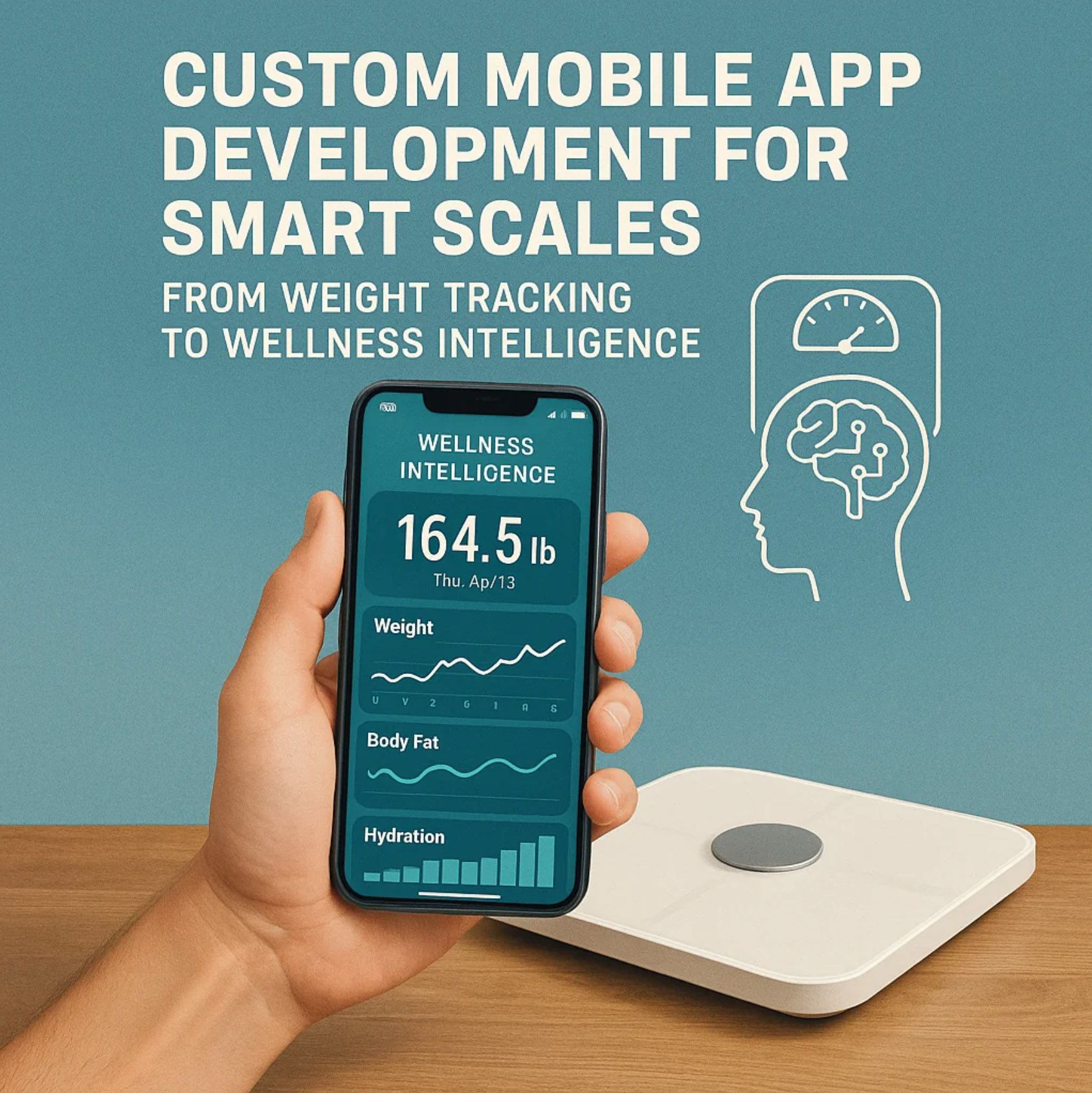
1. Introduction: The Evolution of Smart Scales in the IoT Era
In the rapidly advancing landscape of health and wellness technology, smart scales have emerged as pivotal tools that transcend traditional weight measurement. These devices, integrated with the Internet of Things (IoT), offer users a holistic view of their health by providing detailed metrics such as body fat percentage, muscle mass, and metabolic rate. The fusion of hardware and sophisticated mobile applications has revolutionized how individuals monitor and manage their well-being (TechRadar, EIN Presswire).
The Rise of Smart Scales
The global smart scale market has witnessed significant growth over the past few years. According to a report by The Business Research Company, the market size is projected to expand from $3.35 billion in 2024 to $4.58 billion by 2029, reflecting a compound annual growth rate (CAGR) of 6.4% . This surge is attributed to increasing health consciousness, the prevalence of obesity, and the widespread adoption of smartphones and telehealth services (The Business Research Company).
Smart scales are no longer confined to fitness enthusiasts or medical facilities; they have become mainstream household devices. Their ability to seamlessly sync data with mobile applications allows users to track progress, set goals, and receive personalized health insights. This integration empowers individuals to take proactive steps toward healthier lifestyles (WIRED).
Integration with Mobile Applications
The true potential of smart scales is unlocked through their integration with mobile applications. These apps serve as centralized hubs where users can monitor various health metrics over time. Features such as trend analysis, goal setting, and personalized recommendations enhance user engagement and motivation.
A study published in the Journal of Medical Internet Research highlighted that users who engaged with mobile health applications in conjunction with smart scales exhibited higher activity levels and achieved more significant weight loss compared to those who did not use such integrated systems . This synergy between hardware and software creates a comprehensive health monitoring ecosystem (PMC).

The Role of IoT in Health Monitoring
The incorporation of IoT technology into smart scales has transformed them into intelligent devices capable of real-time data transmission and analysis. This connectivity enables continuous health monitoring, timely feedback, and integration with other smart health devices. Users can now have a unified view of their health data, facilitating informed decision-making and personalized health strategies.
Moreover, the data collected can be invaluable for healthcare providers, allowing for remote patient monitoring and early detection of potential health issues. This advancement aligns with the growing trend of telehealth services, offering convenience and efficiency in healthcare delivery.
The evolution of smart scales epitomizes the convergence of technology and health. As these devices become more sophisticated and integrated with mobile applications, they offer users comprehensive tools for health monitoring and management. The continued growth of the smart scale market underscores their significance in the modern health and wellness landscape. By leveraging IoT capabilities and user-friendly applications, smart scales are poised to play an increasingly vital role in promoting healthier lifestyles and proactive health management.
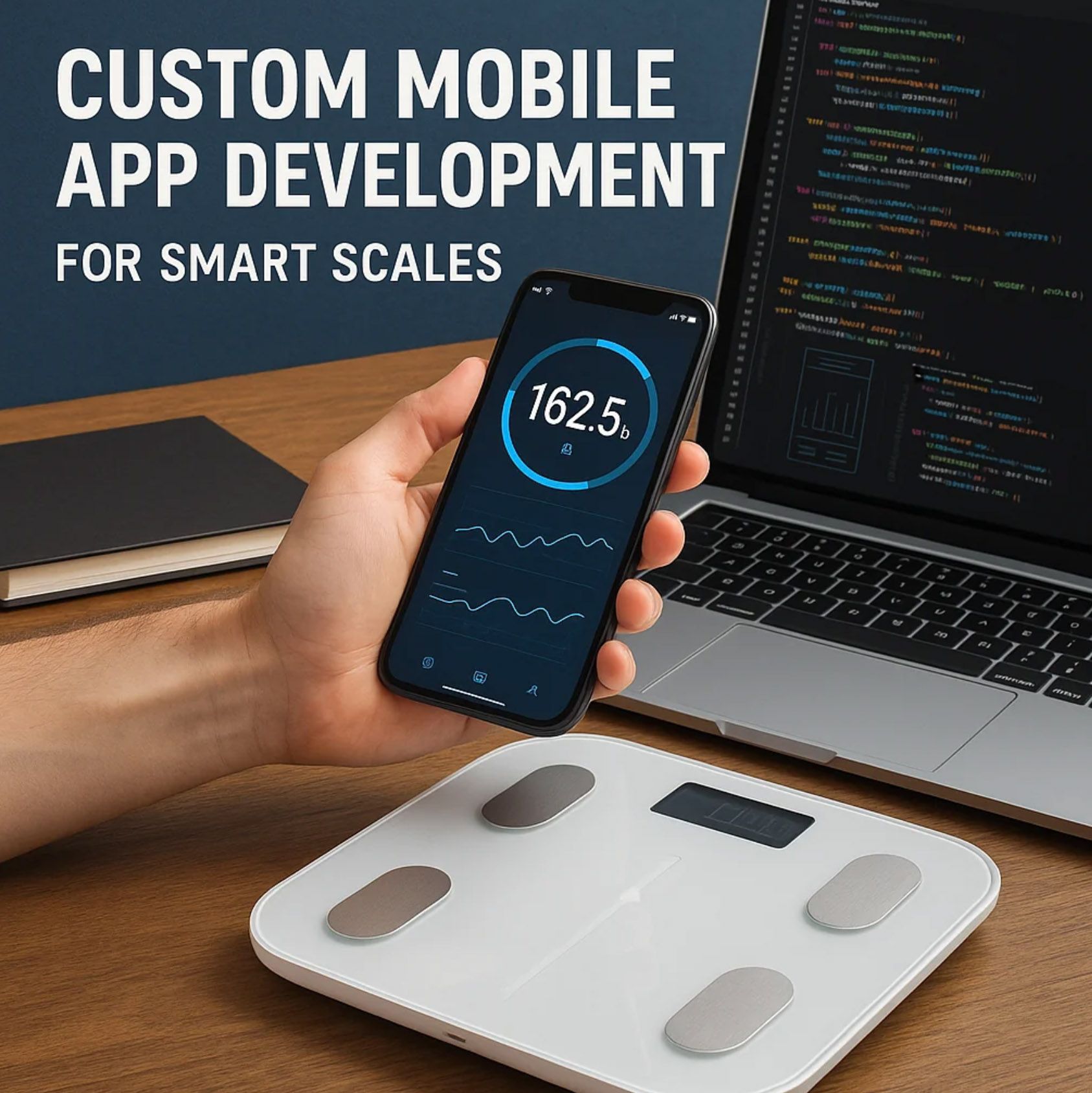
2. Market Landscape: Growth and Opportunities in Smart Scale Technology
The health and wellness industry is undergoing a fundamental transformation, driven in part by the surge of connected devices that deliver data-rich insights to everyday users. At the forefront of this shift are smart bathroom scales, now evolving from simple household gadgets into integral components of broader digital health ecosystems.
📊 Smart Scale Market Overview: Size and Forecast
According to recent data from Statista, the global smart scale market is projected to generate over $5.2 billion in revenue by 2029, growing at a compound annual growth rate (CAGR) of 5.69% between 2025 and 2029. Meanwhile, other estimates, including those from The Business Research Company, place the CAGR between 6% and 7%, depending on whether the data includes commercial and fitness-center applications.
This sustained growth is not a temporary spike but part of a long-term global trend fueled by three dominant forces:
- Increased health awareness,
- Rapid smartphone adoption and connectivity infrastructure,
- And the expanding use of IoT in preventive healthcare.
The smart scale has become more than a weight-measuring device — it now functions as a data collector, behavioral feedback loop, and motivational tool for millions.
🌍 Regional Trends: Where Growth Is Accelerating
- North America
North America remains the largest market, with the U.S. accounting for more than 35% of global revenue in the smart scale category. High consumer awareness, widespread use of fitness apps, and early adoption of IoT-based health devices are core contributors. Additionally, partnerships between smart scale manufacturers and insurance companies or employers have become more common, incentivizing health tracking.
- Europe
In Europe, particularly Germany, France, the Netherlands, and the UK, public health campaigns and government-led digital health initiatives are driving adoption. GDPR compliance and data protection laws also mean European consumers prioritize apps with secure, transparent data handling, creating an opportunity for custom-built solutions with compliant architectures.
- Asia-Pacific
APAC is the fastest-growing region with a CAGR exceeding 7%. The region’s rising middle class, urbanization, and mobile-first behavior patterns drive demand, particularly in China, Japan, South Korea, and India. Local fitness platforms, such as Keep (China) and CureFit (India), are already integrating smart hardware to enrich their service offerings — a model smart scale manufacturers in the West can learn from.
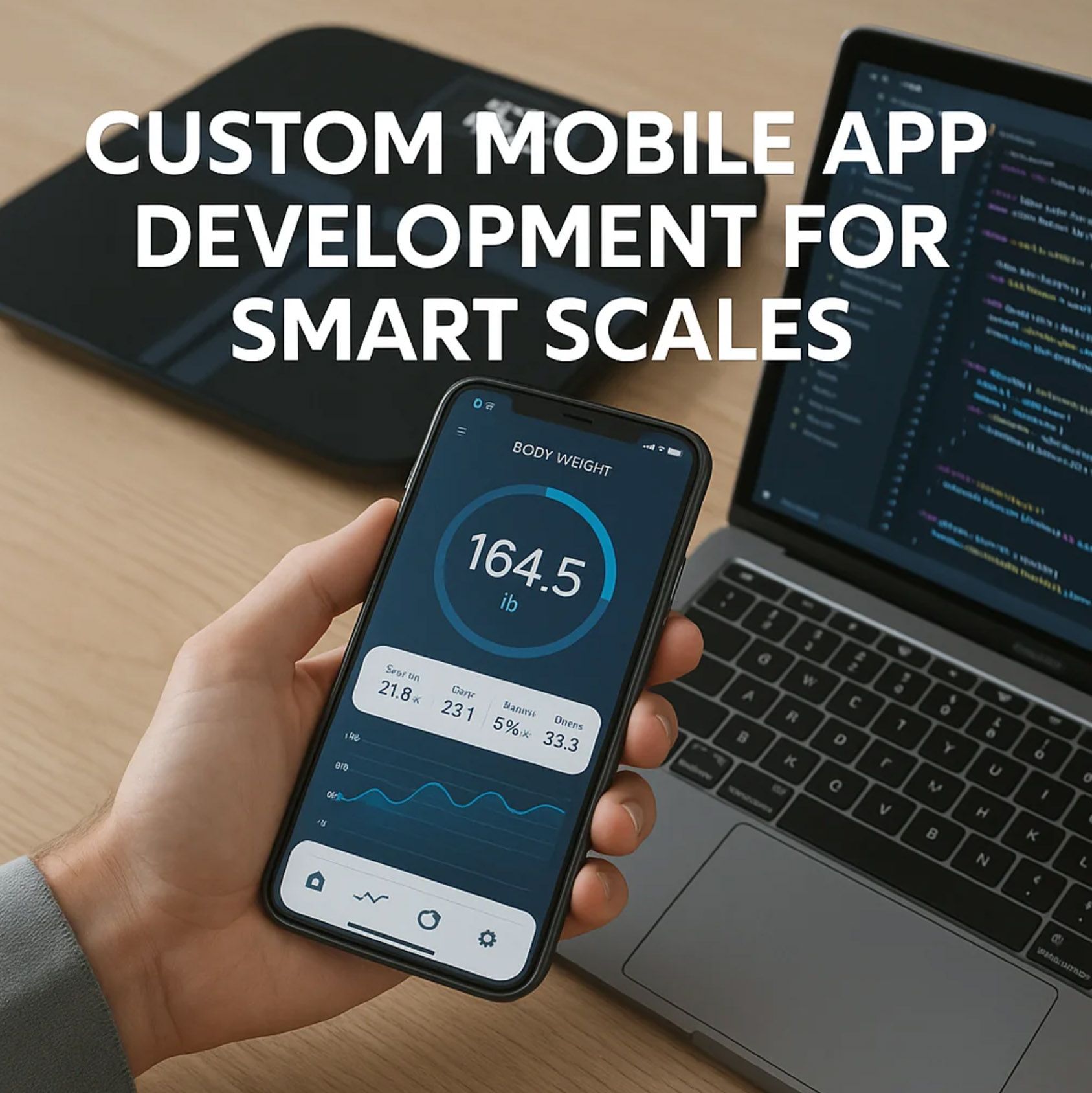
👥 Understanding the User Landscape
The smart scale user base is diversifying. It’s no longer limited to tech-savvy millennials or fitness professionals. Three major user segments now define the market:
- Wellness-focused consumers — people actively trying to lose weight, improve fitness, or optimize health through digital tools.
- Healthcare-integrated users — patients with chronic conditions like hypertension or diabetes, whose treatment is increasingly monitored remotely.
- Institutional buyers — gyms, wellness clinics, corporate wellness programs, and even eldercare centers looking for scalable, integrated systems.
These users expect more than a digital number on a screen. They want goal tracking, nutritional recommendations, visual progress reports, and integration with other apps and wearables.
💡 Emerging Opportunities for Developers & Brands
The market's maturity creates distinct opportunities for smart scale manufacturers and app developers, particularly in the custom software space. Key areas of potential include:
- Multi-device synchronization — allowing the smart scale to interact with smartwatches, health bands, glucose monitors, and smart mirrors.
- Behavioral analytics & coaching — apps that use weight data as input for customized wellness journeys, including meal plans, reminders, and mental health nudges.
- Family and multi-profile support — a crucial but often neglected feature in B2C scenarios where multiple people use one device but need individualized privacy and tracking.
- Telehealth & API access — integrating with clinical platforms and providing HIPAA/GDPR-compliant data access for physicians or insurers.
📈 Business Implications
From a business standpoint, smart scale manufacturers that invest in custom mobile apps can increase device engagement, reduce churn, and open up recurring revenue streams (e.g., personalized coaching subscriptions, meal delivery partnerships). Moreover, apps offer invaluable user data — not for selling, but for building better algorithms, improving UX, and staying ahead of feature demand.
The smart scale market is not just growing — it is evolving. Brands that treat mobile applications as an afterthought risk becoming irrelevant. But those who embrace software as a core layer of the product experience — and build it to suit the needs of tomorrow’s users — will own the most important real estate in digital health: the user’s daily attention.
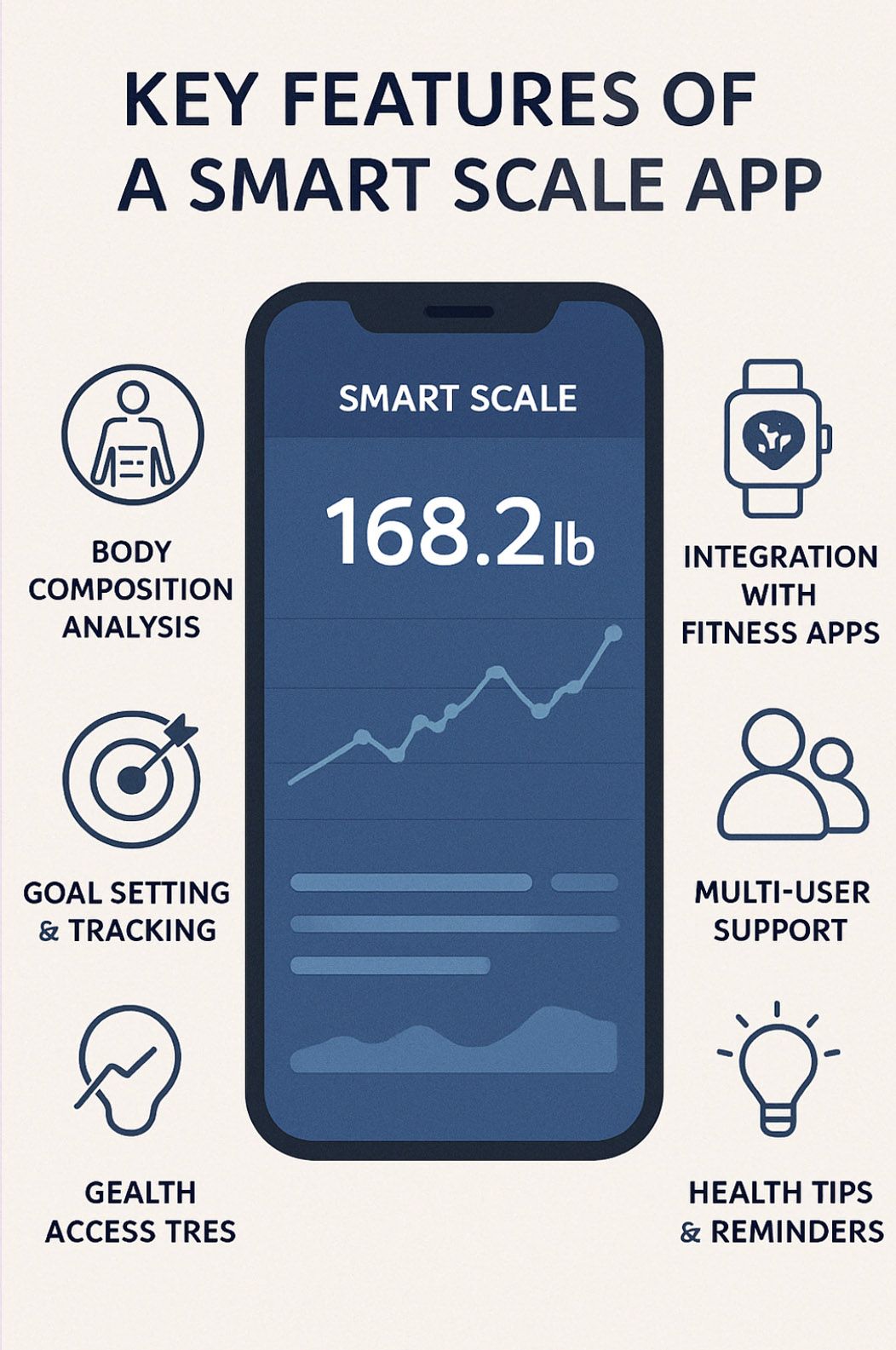
3. Core Features: What Users Expect from Smart Scale Applications
In the rapidly evolving landscape of health and fitness technology, smart scales have transcended their traditional role of merely measuring weight. Modern users anticipate a comprehensive suite of features that offer deeper insights into their health metrics, seamless integration with other health platforms, and personalized experiences that cater to their unique wellness journeys.
Comprehensive Health Metrics
Today's users demand more than just weight readings. They seek detailed body composition analyses, including metrics such as body fat percentage, muscle mass, bone density, and water weight. For instance, the Eufy Smart Scale P2 Pro offers 14 different health metrics, providing users with a holistic view of their physical condition. Such comprehensive data empowers users to make informed decisions about their health and fitness routines. (Etekcity).
Seamless Integration with Health Ecosystems
Integration with popular health and fitness platforms is paramount. Users expect their smart scale applications to sync effortlessly with apps like Apple Health, Google Fit, Fitbit, and MyFitnessPal. This interoperability ensures that all health data is consolidated, providing a unified view of one's wellness journey. For example, the Withings Body Plus scale connects with over 100 third-party apps, enhancing user experience by centralizing health data.
User-Friendly Interface and Experience
An intuitive and aesthetically pleasing user interface significantly enhances user engagement. Applications should present data in a clear, concise manner, utilizing visual aids like graphs and charts to depict trends over time. The Renpho Smart Body Fat Scale app, for instance, is lauded for its straightforward design, allowing users to easily navigate through various health metrics and track their progress (SmartThings Community).
Personalized Feedback and Goal Setting
Personalization is a key driver of user satisfaction. Smart scale applications should offer tailored feedback based on individual health data, suggesting actionable steps to achieve specific health goals. Features like goal setting, progress tracking, and motivational prompts can significantly enhance user commitment. The Wyze Scale Ultra, for example, provides users with customizable screens displaying preferred metrics, fostering a more personalized experience (The Verge).
Multi-User Support and Profile Management
Households often have multiple individuals using the same smart scale. Therefore, applications must support multiple user profiles, ensuring that each user's data remains distinct and confidential. The Greater Goods Smart Weight Scale accommodates up to 10 user profiles, automatically recognizing and syncing data to the appropriate account, thereby simplifying the user experience (withings.com).
Data Privacy and Security
With the increasing sensitivity of health data, users are becoming more concerned about privacy and security. Applications must implement robust security measures, including data encryption and compliance with regulations like GDPR and HIPAA. Transparent privacy policies and user consent mechanisms are essential to build trust and ensure data protection.
Regular Updates and Customer Support
Continuous improvement through regular software updates ensures that applications remain compatible with the latest devices and operating systems. Moreover, responsive customer support addresses user queries and issues promptly, enhancing overall satisfaction. Brands like Withings have established reputations for consistent updates and dedicated customer service, reinforcing user loyalty.
Users expect smart scale applications to be comprehensive, integrative, user-friendly, personalized, secure, and supported by reliable customer service. Meeting these expectations not only enhances user satisfaction but also positions brands competitively in the burgeoning health tech market.
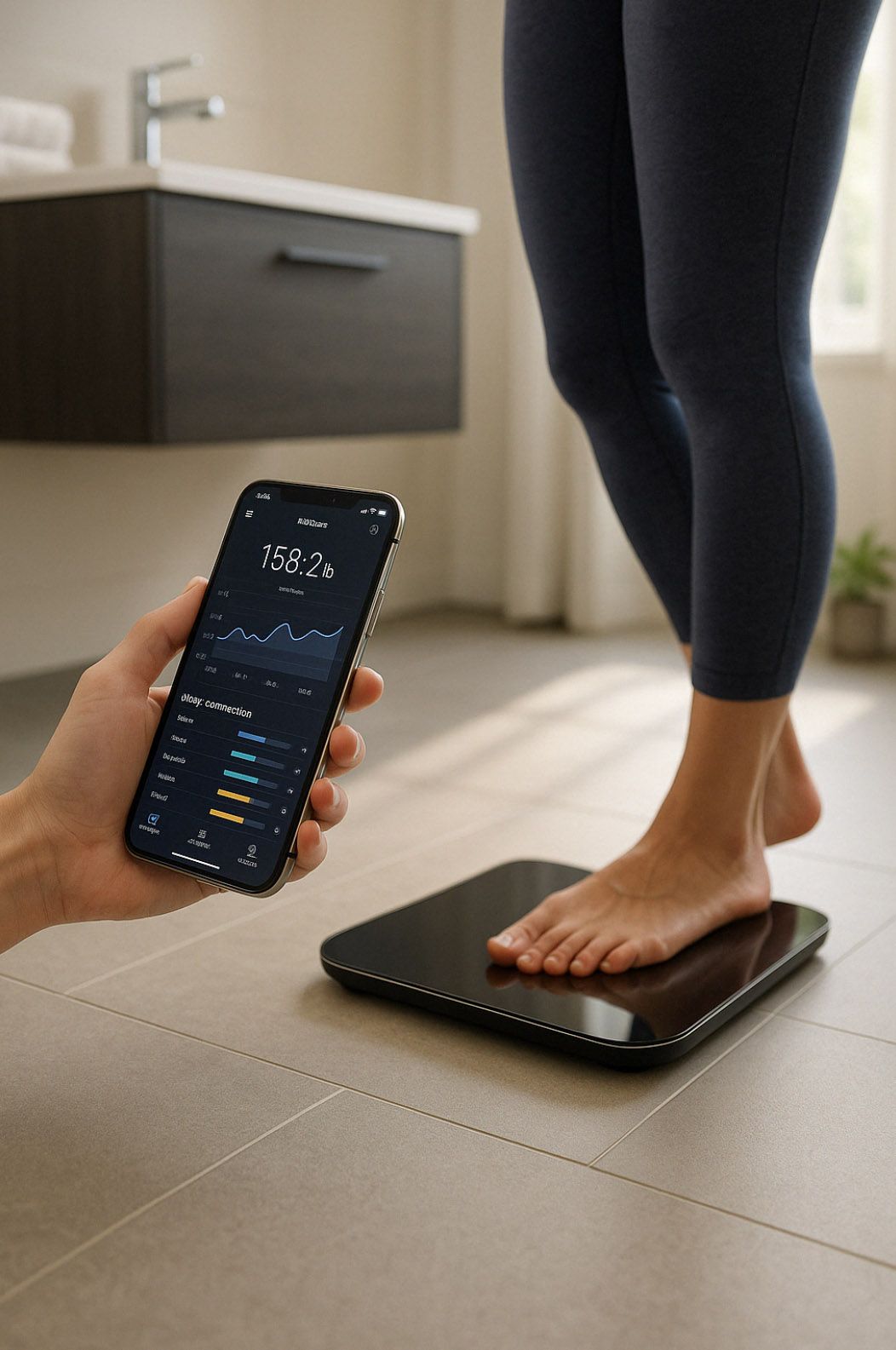
4. Technical Architecture: Building Robust and Scalable Smart Scale Apps
Developing a smart scale application that is both robust and scalable requires a meticulous approach to technical architecture. The foundation of such applications lies in their ability to seamlessly integrate hardware and software components, ensuring accurate data collection, real-time processing, and user-friendly interfaces.
At the core, the application must efficiently handle data transmission from the smart scale to the user's device. This involves implementing reliable communication protocols, such as Bluetooth Low Energy (BLE) or Wi-Fi, to facilitate real-time data exchange. Ensuring minimal latency and high data integrity during this transmission is crucial for providing users with instantaneous feedback on their health metrics (Wyze Forum).
Beyond data transmission, the application should be designed with a modular architecture. This approach allows for scalability, enabling developers to introduce new features or integrate additional health metrics without overhauling the entire system. For instance, incorporating modules for tracking dietary habits or physical activity can enhance the application's utility, offering users a comprehensive health monitoring tool.
Data storage and security are paramount. Implementing secure cloud storage solutions ensures that users' health data is safely backed up and accessible across multiple devices. Moreover, adhering to data protection regulations, such as the General Data Protection Regulation (GDPR) or the Health Insurance Portability and Accountability Act (HIPAA), is essential. As one industry expert aptly stated:
"In the realm of health applications, user trust is built on the pillars of data security and privacy. Ensuring compliance with global standards is not just a legal obligation but a commitment to user well-being."
User interface (UI) and user experience (UX) design play a significant role in the application's success. An intuitive UI ensures that users can effortlessly navigate through the application, access their health data, and understand their progress. Incorporating visual aids, such as graphs and charts, can help users better interpret their health metrics. A recent review highlighted this aspect: WIRED.
"The scale is sleek and modern, fitting perfectly into my bathroom setup. What truly sets it apart is its accuracy and smart features. It not only measures weight but also tracks body fat percentage, BMI, and other metrics, which is incredibly helpful for staying on top of my fitness goals." (Apple).
Furthermore, the application should support multi-user profiles, catering to households where multiple individuals use the same smart scale. Implementing user recognition features, possibly through weight differentiation or user selection prompts, can ensure that data is accurately attributed to the correct individual.
Lastly, integrating the application with other health and fitness platforms can significantly enhance its value proposition. By allowing data synchronization with platforms like Apple Health, Google Fit, or Fitbit, users can have a centralized view of their health metrics, fostering a more holistic approach to personal wellness.
In conclusion, building a robust and scalable smart scale application necessitates a harmonious blend of reliable data transmission, modular architecture, stringent data security, intuitive design, and interoperability with other health platforms. By focusing on these technical aspects, developers can create applications that not only meet user expectations but also contribute meaningfully to their health journeys.
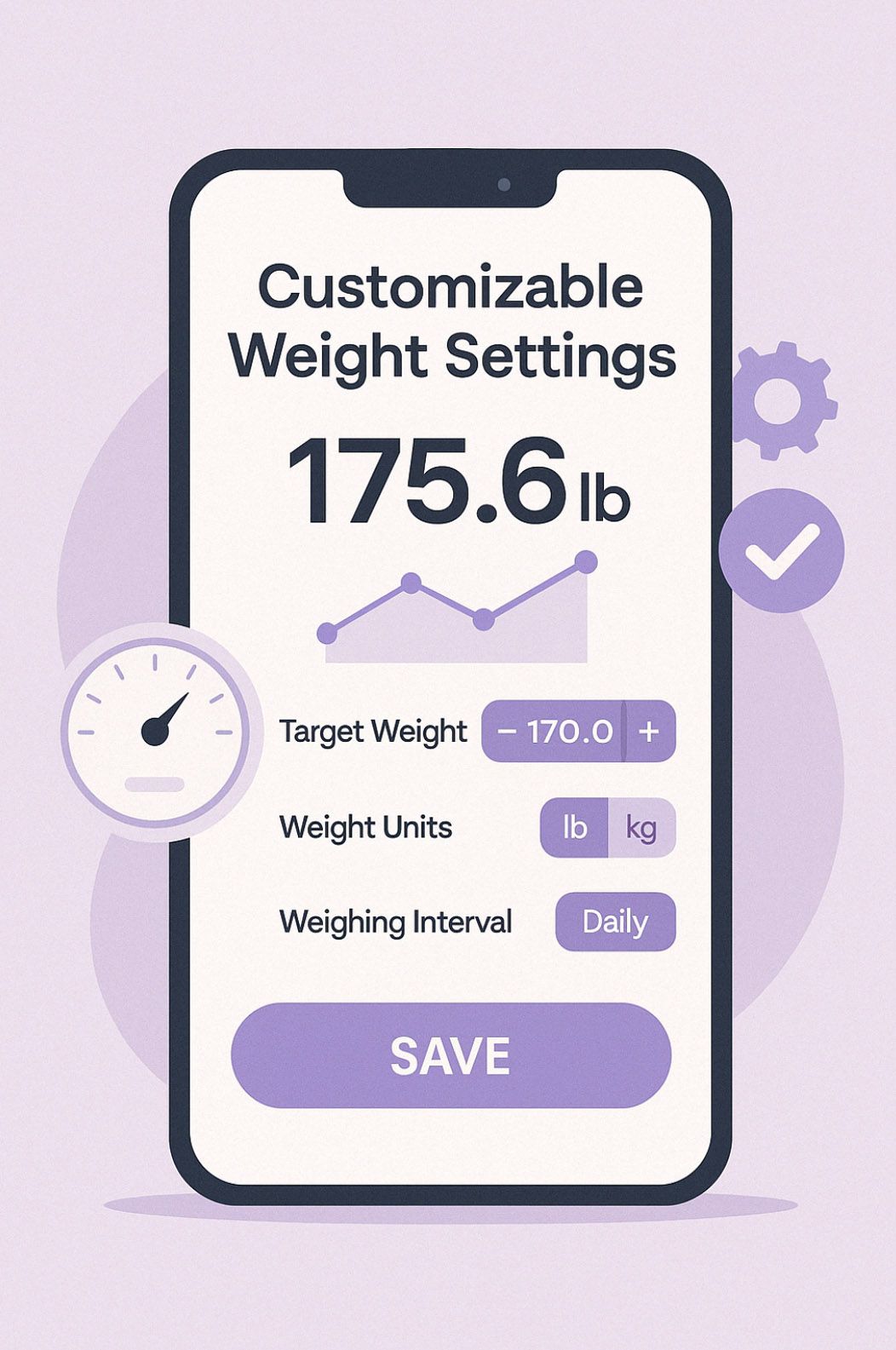
5. Future Outlook: The Next Frontier in Smart Scale Technology
As the smart scale market continues to expand, the conversation is shifting from “what does it measure?” to “what does it enable?” The future of smart scales will not be defined by sensors or displays alone, but by how seamlessly these devices integrate into users’ daily lives, health goals, and the wider digital wellness ecosystem. For manufacturers, the path forward is clear: those who invest in building scalable, adaptive, and experience-centered digital platforms will not just sell hardware — they will shape how we think about health at home.
🧠 Smarter Insights Through AI-Powered Personalization
Today’s smart scales offer metrics. Tomorrow’s smart scales will offer meaning.
Machine learning algorithms will soon transform weight and composition data into personalized coaching. For example, a scale may recognize a plateau in weight loss, cross-reference it with activity levels, and push a mobile notification: “You’ve been steady for 10 days — time to switch up your workout routine?” Or it may identify abnormal fluctuations and ask: “Is this change intentional or unexpected?” This predictive, context-aware layer is where value truly compounds.
A 2024 case study from Withings' Health+ platform shows that users who received AI-driven feedback were 34% more likely to maintain long-term usage of their devices compared to users without personalization features.
This future demands that manufacturers partner with development teams who not only build apps but understand data flows, behavioral UX, and AI model integration — precisely the terrain where A-Bots.com operates.
🏥 Integration with Telehealth and Insurance-Linked Wellness
Smart scales that sync with telehealth dashboards allow physicians to monitor patients with chronic conditions — hypertension, diabetes, obesity — in real time.
In the U.S., health insurers are already piloting programs where members receive smart scales and incentives for consistent usage. But such programs require apps that do more than record weight. They need secure API access, data retention policies, multi-user role management, and white-labeled environments that can integrate with Electronic Health Record (EHR) systems.
This is not something you can build with a generic SDK. It requires a custom, compliance-ready architecture.
🌐 Ecosystem Thinking: Scales as Just One Node
Tomorrow’s smart scale won’t stand alone. It will speak with smart water bottles, fitness trackers, calorie intake apps, digital mirrors, and even mental wellness platforms.
Manufacturers that treat their mobile app as a walled garden will fall behind. Users expect unified dashboards that connect all their tools. Developers, in turn, must think in terms of modular APIs, data normalization, and cross-platform compatibility.
The scale becomes not just a product — but a participant in a personal wellness system.
📶 Hardware Will Be Commoditized. The App Won’t.
Let’s be blunt. Load cells and glass panels are easy to replicate. Bluetooth modules come from the same 3 factories. The differentiator is software.
Manufacturers that rely on generic companion apps risk becoming indistinguishable in a crowded marketplace. But those who invest in unique, branded, intelligently designed applications will enjoy:
- Higher user engagement
- Better product reviews
- Recurring subscription revenue
- Stronger loyalty and retention
That’s not a “nice to have.” That’s your margin.
🪞A Glimpse of the Near Future
Imagine a user steps onto a scale. The app immediately displays:
- A real-time trendline
- Recommended caloric intake based on the past week
- An alert to hydrate more (synced from their smart bottle)
- A message: “Congrats — your visceral fat dropped 3% since last check-in”
That’s not a dream. That’s what’s being built — today.
“The next generation of smart health products won’t compete on features. They’ll compete on how intelligently they use data to make people feel seen, understood, and supported.” — A-Bots.com, Strategy Memo 2025.
And maybe — just maybe — we’ll still find time for humor:
Why did the smart scale dump its user?
Because they kept stepping on it with emotional baggage!
🚀 Final Thought
If you're a hardware brand serious about owning the future of digital wellness, your software must do more than sync.
It must engage, empower, and adapt.
That’s the kind of mobile ecosystem A-Bots.com builds.
Let’s create something the future will stand on.
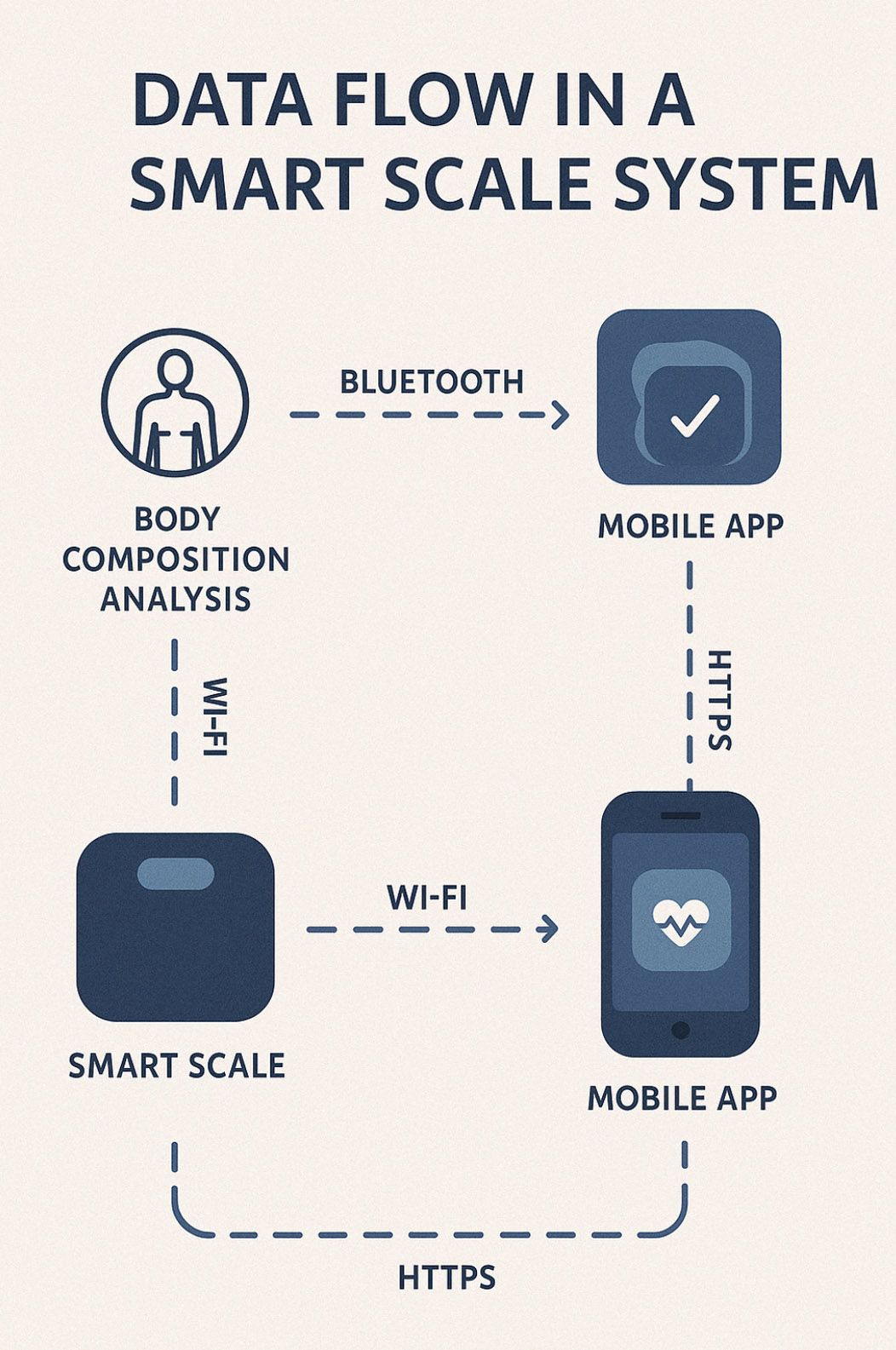
Hashtags
#SmartScales
#WellnessApps
#IoTDevelopment
#MobileHealth
#FitnessTech
#AppDevelopment
#ConnectedDevices
#CustomSoftware
#ABots
#SmartWellness
Other articles
Custom CRM for Real Estate Developers Off-the-shelf CRM tools weren’t built for the complexity of real estate development — but we were. This in-depth article explores why custom CRM solutions are redefining how developers manage projects, leads, teams, and revenue. See real-world ROI calculations, key challenges, and expert insights from A-Bots.com, a top CRM development company.
Custom Agriculture App Development for Farmers In 2024, U.S. farmers are more connected than ever — with 82% using smartphones and 85% having internet access. This article explores how mobile applications are transforming everyday operations, from drone-guided field scouting to livestock health tracking and predictive equipment maintenance. It examines why off-the-shelf apps often fail to address specific farm needs and how collaborative, farmer-funded app development is gaining momentum. Through real-world examples and step-by-step guidance, readers will learn how communities of growers can fund, design, and launch custom apps that fit their exact workflows. A-Bots.com offers tailored development services that support both solo farmers and agricultural groups. With offline capabilities, modular design, and support for U.S. and international compliance, these apps grow alongside the farm. Whether you're planting soybeans in Iowa, raising cattle in Texas, or running a greenhouse in California — this article offers the tools and inspiration to build your own farm technology. Discover why more farmers are saying: we don’t wait for the future — we build it.
Custom Drone Mapping Software & Control Apps: Smarter Aerial Solutions by A-Bots.com Custom drone software is revolutionizing how industries operate—from precision agriculture to infrastructure inspection. This article explores why off-the-shelf apps fall short, how AI and modular design shape the future, and how A-Bots.com delivers tailored drone solutions that truly fit. Whether you manage crops, assets, or entire projects, the right software lifts your mission higher.
Custom IoT for Smart Greenhouses and Vertical Farms Modern greenhouses and vertical farms demand more than off-the-shelf solutions. In this article, discover how custom IoT systems — built around your space, your crops, and your team — can unlock new levels of efficiency, automation, and yield. Packed with real-world examples, insights from A-Bots.com engineers, and expert advice, this guide will inspire your next step in smart agriculture. If you're ready to grow smarter — start here.
Custom Coffee Machine App Development Smart coffee is no longer just about flavor — it's about experience. Discover how custom mobile apps for coffee machines unlock new revenue streams, elevate user engagement, and enhance brand loyalty. Backed by real IoT projects, A-Bots.com delivers world-class app solutions that blend tech with taste. Brew the future with us.
Custom Mobile App Development for Smart Wine Cabinets Smart wine cabinets are revolutionizing how wine is stored, served, and experienced. But without a tailored mobile app, their potential remains untapped. This article explores how custom app development turns connected appliances into lifestyle platforms. From inventory tracking and AI-powered recommendations to enterprise-grade restaurant integrations, the right app changes everything. We cover technical architecture, design principles, and real-world use cases. Whether you're a wine lover, hotelier, or hardware brand, you'll discover why mobile UX is now core to wine storage. A-Bots.com delivers expert, future-ready solutions tailored to this niche.
Mobile App Development for Lawn Mowers Smart lawn mowers are transforming how homeowners and businesses manage outdoor spaces. But without powerful software, even the best mower is just hardware. This article explores how custom mobile apps enhance the robotic mowing experience with features like GPS mapping, dynamic scheduling, and real-time feedback. From residential use to commercial landscaping, the impact is clear. We examine the tech architecture behind connected mowers and the critical role apps play in user satisfaction. You'll also learn why off-the-shelf solutions fall short — and how A-Bots.com builds tailored experiences that go far beyond expectations. Whether you're a manufacturer or a visionary startup, this article offers a roadmap to the future of lawn automation.
Mobile App Development for Smart Pet Feeders Smart pet feeders are no longer luxury gadgets — they are becoming vital tools in modern pet care. But their true power is unlocked only through intuitive, connected mobile apps. This article explores how custom software development elevates the user experience far beyond off-the-shelf solutions. From feeding schedules to AI-driven health monitoring, we break down what pet owners truly expect. We analyze the market, dissect real product cases, and outline the technical architecture behind dependable smart devices. Most importantly, we show why hardware manufacturers need the right digital partner. A-Bots.com delivers the kind of app experience that builds trust, loyalty, and long-term value.
Top stories
Copyright © Alpha Systems LTD All rights reserved.
Made with ❤️ by A-BOTS
